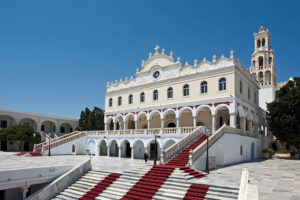

Tinos (Greek: Τήνος) is a Greek island situated in the Aegean Sea. It is located in the Cyclades archipelago. In antiquity, Tinos was also known as Ophiussa (from ophis, Greek for snake) and Hydroessa (from hydor, Greek for water).
Tinos is famous amongst Greeks for the Church of Panagia Evangelistria, its 80 or so windmills, about 1000 artistic dovecotes, 50 active villages and its Venetian fortifications at the mountain, Exomvourgo. On Tinos, both Greek Orthodox and Roman Catholic populations co-exist, and the island is also well known for its famous sculptors and painters, such as Nicholaos Gysis, Yannoulis Chalepas and Nikiforos Lytras.

History
Following the capture of Constantinople by the Fourth Crusade, Tinos was one of several islands ruled by private Venetian citizens and belonged to Geremia Ghisi, whose heirs held it until 1390 when the last member of the family branch bequeathed both Tinos and Mykonos to Venice. It was ruled by Venice until 1715, when Tinos was captured by the Ottoman Empire (see Ottoman–Venetian War), and became known as İstendil. The Ottomans held Tinos until 1821 when the inhabitants joined in the Greek War of Independence.
The tumult of the period gave raise to an increase in piracy in the region. In 1825 HMS Cambrian was lead vessel of a small squadron in anti-piracy operations in the Archipelago, at Alexandria, and around the coasts of Syria. On 27 July 1826 Cambrian’s boats captured a pirate bombard and burnt a mistico on Tinos. Five pirates were killed and several wounded.
Source Wikipedia.
Be the first to comment